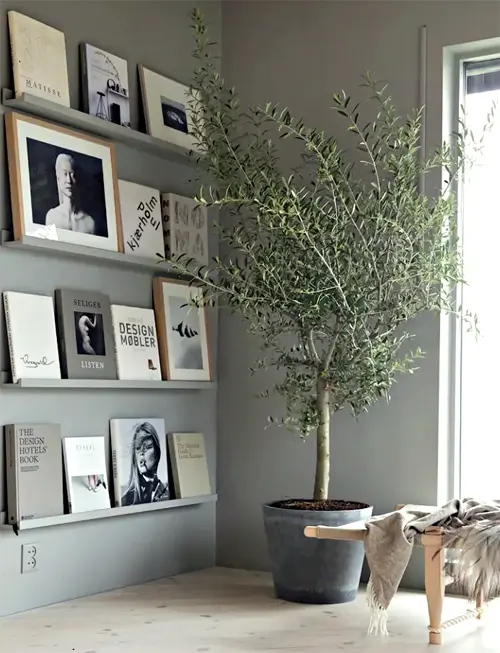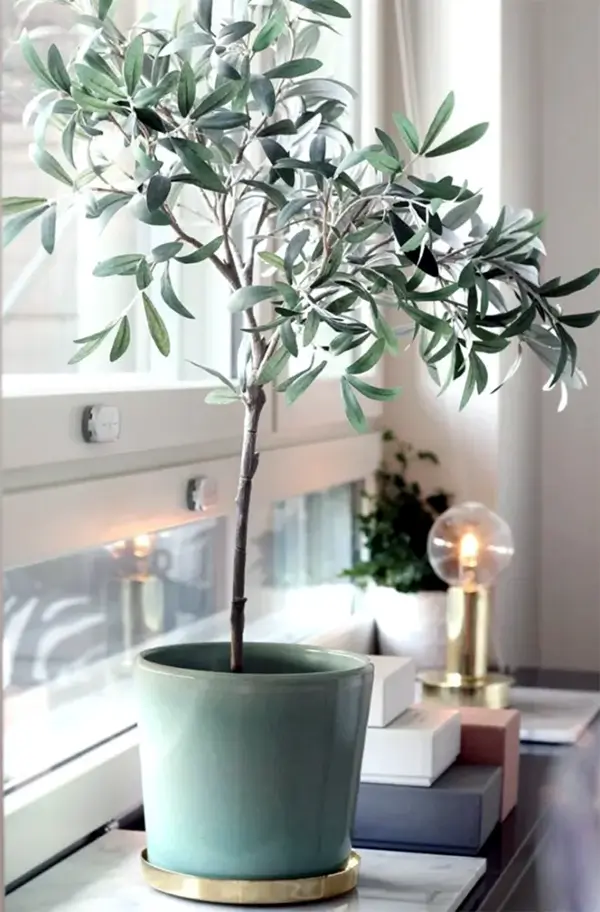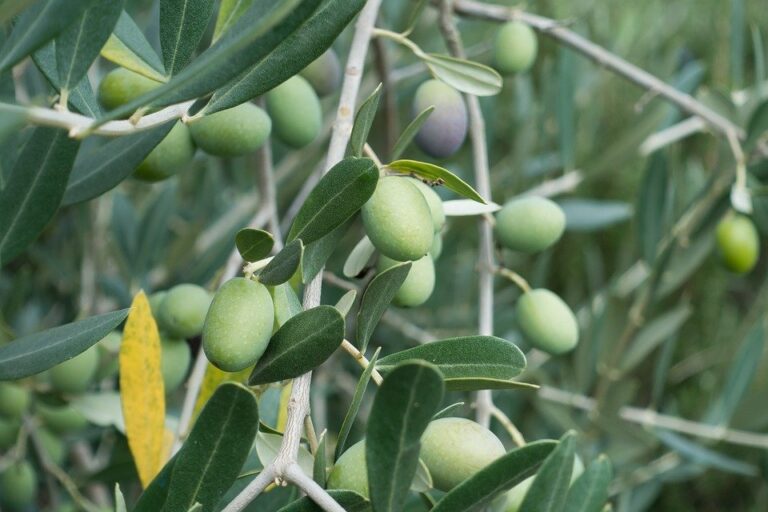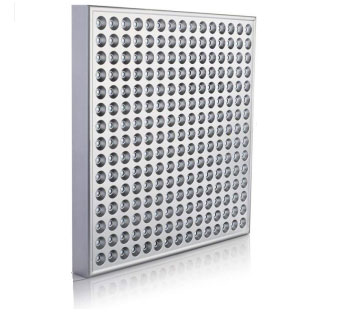Table of contents
ToggleCare and winterisation of the olive tree
The olive tree has become a popular tree in Denmark, where many enjoy the beautiful evergreen tree in pots on the terrace. The olive tree, Olea Europaea, is characterized by elongated green leaves, white fragrant flowers and olive fruits. The wood is very decorative and can create the southern atmosphere both at home on your terrace, on your balcony or in your conservatory.
In the tropical and subtropical climate where we know the olive trees from, it can grow up to 15 meters high, but in our climate in Denmark the tree typically grows to a few meters, with slow growth. Therefore, it is perfect for pots in the garden, as it also makes the tree easier to look after, as it is necessary to adapt the tree's needs according to the weather and the season in Denmark.
When buying an olive tree, there are several things you need to be aware of. The tree is a very demanding species and it's not exactly beginner-friendly. Among other things, overwintering olive trees can be difficult if you don't have a lot of experience or have done your homework and read this article. This article will explain the entire process of winterising olive trees.
Location of the olive tree
The best place for your olive tree is a sunny, warm spot with calm wind conditions. Buying it between March and June gives the best possible results, after which the tree is transplanted into a large and stable pot, otherwise the light tree may fall over in strong winds. A large pot is also an advantage, as the tree will not tolerate being replanted too often. Next, it's important to have drainage at the bottom of the pot so that the water can drain away and the tree doesn't get wet roots.
Selection of soil type
When you have to plant the olive tree in your pot, it is important to have the right type of soil, as the tree thrives best in a very clayey soil. There is a special soil, called Mediterranean soil, which is just for this purpose. With Mediterranean soil, your tree gets exactly the right nutrients, and you can find this type of soil in your garden centre. The type of soil is important, as it is decisive for the green color of the leaves. The olive tree is planted in the ground at the same depth as the pot you buy the tree in.
Irrigation and fertilization of olive trees
It is important not to overwater olive trees. Better let the tree dry out a little between waterings. Finding the right balance can be a bit of a challenge. Keep an eye on the leaves. If your tree gets yellow leaves that fall off, it is often due to too much water, while it can be due to too little water if the tree loses its green leaves.
However, it is important with a newly planted olive tree to water a little more as the root system is still forming. Fertiliser is often not necessary. If you do fertilise, be careful not to over-fertilise as this can turn the leaves brown. You can add liquid fertiliser occasionally when watering to promote growth, flowering and fruiting. Check the correct dosage on your fertiliser product.
Wintering of olive trees
The olive tree can tolerate a little frost, but the roots are delicate, and there are therefore several things you must pay attention to so that your olive trees can make it through a winter with hard frost. In the period from November to April, the ideal place for your olive tree is an unheated conservatory or greenhouse with heat, a bright place and with temperatures between 5-10 degrees, The olive tree must under no circumstances get frost.
Overwintering olive trees can also be done in, for example, a garden shed, but here grow lights an absolute necessity.
If you do not have these options, you can put your tree close to a wall in shelter, and cover the pot with a winter mat, blankets or bubble wrap, which keeps the soil free from frost.
You can protect the tree's branches with spruce branches or fiber cloth or wrap the tree in a winter protection bag for plants. It is important to reduce watering during the winter period. The soil should only be kept slightly moist.
Another option for overwintering olive trees is that you can have them stored at a plant hotel, where they are looked after and cared for over the winter, but of course this costs money.


Remember to grow lights for your olive tree
If you choose to bring your tree into the living room during the winter period, there are several conditions that you must pay particular attention to. Because this is not the optimal solution for overwintering olive trees, among other things due to light and temperature conditions.
Here, extra watering is necessary, preferably use a sprayer for the leaves, and then you can add a good full-spectrum grow light lamp. We recommend a full-spectrum lamp with white light, as it is most similar to the daylight that olive trees grow under outdoors.
- For smaller olive trees up to 40-80cm in height, one should be chosen grow lights lamp or pit bulbs of around 35-40 Watt output power (e.g. grow light panel).
- For between olive trees of 80-150 cm, about 80-110Watt plant lamp.
- For large olive trees, you should go up to a +200Watt lamp to get the desired effect, but for large trees it is very individual from tree to tree how much light they need, see if possible. our selection of grolys lamps here.
Therefore, it is recommended that you contact us for concrete advice for your particular plant for the optimal conditions.
Olive tree pruning
After the winter period, pruning may be needed, especially if the tree has been affected by a harsh winter. You can prune heavily, but after that it is important that the tree stands in the shade for two months so that it can grow slowly. New small trees can be given a denser tree crown by pinching the shoot tips, while for older trees you can only prune the tree in between. If you want flowers and fruits on your olive tree, you must let the tree grow for a few years without pruning, as many shoots will eventually come and bloom.
Pests in the tree
Keep an eye out for pests in your olive tree. The pests that typically affect the tree are mealybugs and scale insects. Wool louse are white and look like small tufts of cotton wool, they are mostly on the upper side of the leaves and stems, woolly aphids can cause the plant to suffer and lose its leaves. They can be treated with means against harmful insects, or the infested areas can be cut off.
Scabies can be seen on the back of the leaves and on the branches as brown spots. They can be removed by scraping them off or treating the plant with insect soap. Insect soap basically consists of water, soap and alcohol. You can find many different products on the market, but they can be relatively expensive to buy. However, you can easily make a cheap and effective insect repellent at home. Simply use some liquid brown soap, a bottle of rubbing alcohol and water mixed together and sprayed on the plant, after about 1 hour or 2 it will wash off again. Repeat the treatment as needed until all insects have disappeared. Alternatively, you can use SMC - SpiderMite Control from Growth Technologywhich is also effective against spider mites in lemon trees.
How to care for your olive tree
- Plant your olive tree in a large pot with drainage at the bottom
- The soil must be clayey, preferably Mediterranean soil
- Be careful with overwatering and let the tree dry out a little between waterings
- The tree is placed outdoors in a sunny, sheltered place during the summer
- In the winter period, during the wintering of olive trees, the optimal conditions for the tree are in a cool and frost-free conservatory with temperatures between 5-10 degrees. If you do not have this option, you can see other solutions in the table below and what you should be aware of.
Possibilities for wintering of olive trees | What should you pay attention to? wintering of olive trees |
| Conservatory | A cool and frost-free conservatory A bright place |
| Greenhouse or orangery | Heated and frost-free greenhouse |
| Outdoor | Put in shelter against a wall Jar is wrapped in winter mats or bubble wrap Protect branches with spruce branches or fiber cloth Pack any the tree into a winter protection bag |
| Plant hotel | Your tree is cared for at the plant hotel during the winter period You pay for care |
| Indoors | A cool place Provide extra watering and grow lights Be aware of temperature fluctuations |
If you need help with wintering of olive trees or to choosing the right plant lamp for your tree, you are welcome to contact us at phone or email.
Can an olive tree be left outside all year round
An olive tree can be placed both indoors and outdoors but is not suitable for wintering outside as it cannot withstand frost, so plant it in a pot to make it easier to move it
Can you have an olive tree inside
You need to pay a little more attention to watering when the tree is indoors, so always check if the soil is moist. It can be a bit more demanding to have it as a houseplant, but a nice challenge that brings joy and cosiness.
Can the olive tree withstand frost
Depending on variety and age, the olive tree can tolerate light frost. Some varieties and younger trees are more sensitive to cold, which can damage or kill the tree if left for long periods below -10ºC.
When to prune an olive tree
As temperatures rise in spring (March-May), it starts to become active with new leaf growth and flowering. The main growing season (June-August) continues to develop leaves and flowers that later turn into olives.
The best time to prune is in spring (March-April) right after the cold winter and before the new growth on the olive tree. Avoid pruning in summer when the tree is growing and in winter when it is dormant and vulnerable to the cold.
Can you eat olives directly from the tree
Olives often have a bitter flavour, so you can't just pick the fruit from the tree and eat it, they need to be pickled for them to be good.






